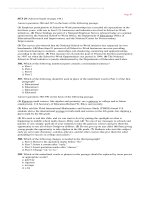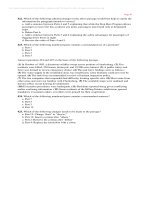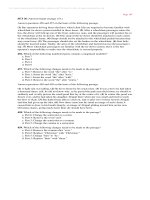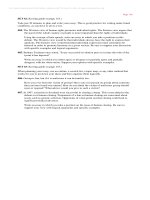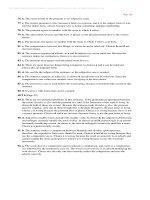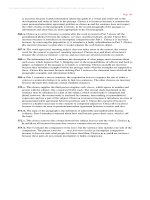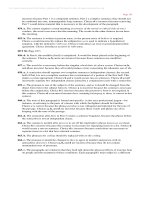501 grammar and writing 3e phần 9 ppt
Bạn đang xem bản rút gọn của tài liệu. Xem và tải ngay bản đầy đủ của tài liệu tại đây (95.94 KB, 13 trang )
SET 26 (Page 46)
277. d. Adjectives modify nouns and adverbs
modify verbs. In choice d, the adjectives
frightening and unhappy correctly modify
the noun ending. In choices a and b, the
adverb frighteningly incorrectly attempts to
modify a noun. In choice c, the adverb—
unhappily—incorrectly attempts to modify
a noun. Choice e is unnecessarily wordy.
278. b. The sentence makes a comparison between
Adela and all other members of the gradu-
ating class; therefore, the superlative form
most should be used. Choices a and d are
wrong because they use the comparative
more.Choicec is wrong because the word
importantly is an adverb and cannot modify
the noun member. Choice e is wrong
because it uses the word like incorrectly.
279. a. The word than is a conjunction used to
indicate a comparison, and used as a
conjunction, it is followed by the the
pronoun I. The word conservatively is an
adverb modifying the verb dresses. Choice a
is the only one that correctly makes the
comparison and uses the adverb correctly.
280. e. This is the correct choice because the
sentence does not contain a double
negative. The other choices either use two
negative words within a single sentence or
use an incorrect comparative form of easy.
281. a. The sentence compares an individual and
an entire crowd of individuals; therefore, it
requires a superlative. Only choice a
coherently uses the superlative happiest to
make the comparison among all the many
people in the crowd.
282. d. When a comparison is made, the word
fewer is used with nouns that can be
counted; the word less is used with
quantities that cannot be counted.
283. d. This sentence makes a comparison
between strip mining and all other types of
mining; therefore, it requires a superlative.
Choices a and b compare only two things
while choice e inappropriately uses an
adverb. Choice
c uses a double superlative
and is redundant.
SET 27 (Page 47)
284. d. There are no errors.
285. a. The adjective sad should be replaced with
the adverb sadly, which correctly modifies
the verb wandered.
286. a. This sentence contains a double negative.
287. d. There are no errors.
288. d. There are no errors.
289. a. This sentence has a usage error: fewer
cookies, not less cookies.
290. d. There are no errors.
291. a. Between is only used to refer to two things.
Among is the correct word to use in this
sentence.
292. d. There are no errors.
293. c. Most awfulest is a double superlative, and
therefore redundant.
Section 5: Paragraph Development
SET 28 (Page 50)
294. a. This is the best choice because it is the only
one that refers to recycling containers,
which is the main focus of this paragraph.
The other choices are statements about
recycling in general.
295. b. This is the only choice that mentions
telecommuting, which is the main focus
of this paragraph. The other choices are
too general.
– ANSWERS–
116
296. c. This choice refers to “unreasonable
searches,” which is the main focus of this
paragraph. Choice a can be ruled out
because this idea is not developed by the
other two sentences. Choices b and d do
not relate to the topic of unreasonable
searches.
297. b. This choice clearly fits with the main focus
of the paragraph, which is the skill that is
needed to hand-rear orphaned baby birds.
Choice a is too vague to be a topic sentence.
Choices c and d introduce other topics.
298. c. The main focus of the paragraph is the
height of a wave. This is the only choice
that introduces that topic.
299. a. The paragraph expresses the writer’s opin-
ion about respect for the law. Choices b and
d can be ruled out because they are irrele-
vant to the main topic. Choice c can also be
eliminated because it discusses respect for
other people, not respect for the law.
300. b. Choice b addresses both of Gary’s vanities:
his person and his situation. Choice a deals
only with Gary’s vanity of person. Choice c
deals only with his vanity of position.
Choice d is not supported in the passage.
301. d. Changing the course of history and nations
going to war implies that the subject of the
paragraph is history; these phrases also
connote danger and intrigue.
302. a. This is the only choice that is in keeping
with the main focus of the paragraph.
Although dogs are mentioned in the
paragraph, choices b and c can be ruled out
because Sentences 2 and 3 do not logically
follow either choice.
303. b. This choice focuses the paragraph by
speaking of a particular patterned corridor,
as is described in the rest of the paragraph.
Choices a and c only speak of patterned
corridors in general. Choice d is
contradicted in the passage.
304. b. This choice is most relevant to the rest of
the paragraph, which is about protecting
children from swallowing dangerous
medications. Choices a and d do not
mention danger; choice c does not mention
protection and is also written in a different
style than the rest of the paragraph.
305. a. This sentence contrasts writers who
endanger their lives in order to have
something to write about with those who
do not. The rest of the paragraph illustrates
this statement. Choice b is too broad.
Choices c
and d contain elements not
expressed in the passage.
306. d. This choice specifically defines the kind of
hearsay evidence that is admissible in a trial
and would be logically followed by a
definition of the kind of hearsay evidence
that is inadmissible. It works better as a
topic sentence than choice c, which is more
general. Choices a and b contradict the rest
of the paragraph.
307. c. Choice c is the only choice that prepares
the reader for the fact that the paragraph
constitutes a set of instructions for workers.
308. d. Choice d is the only sentence that focuses
on both the tickler and its usefulness to sec-
retaries, and therefore is relevant to all the
other sentences in the paragraph. Choices a
and b are too general to effectively focus the
paragraph; choice c is too narrow.
309. c. This choice focuses most sharply on the
main topic of the paragraph—muscle
atrophy and bone loss. Choices a and b are
too broad to guide the reader to the focus
of the paragraph. Choice d is too limited.
310. a. The word rather indicates a contrast to
whatever came before. Choice a is the only
sentence that guides the reader to the con-
trast between the old definition of asthma
and the new. Choices b and c are less pre-
cisely related to the new understanding of
asthma. Choice d is not related at all.
– ANSWERS–
117
311. a. Choice a is more specific than the other
choices and more sharply focused toward
the entire paragraph. Choices b and d are
more vague and general, and choice c is
written in a slightly different, more
upbeat style.
SET 29 (Page 55)
312. a. Choice a expands on the topic sentence.
Choices b and c do not relate directly to
indoor pollution. The style of choice d is
more informal than that of the topic
sentence.
313. c. This choice directly illustrates the topic
sentence. Choice a does not mention the
Middle Ages, choice b does not mention
red hair, and choice d is unrelated to the
topic sentence.
314. a. Choice a relates directly to self-medication.
The other choices do not.
315. c. The idea expressed in the topic sentence is
counterintuitive, as stated in choice c. (The
words This idea also gives an important
clue, since an idea is the subject of the topic
sentence.) The other choices do not relate
directly to the nature of light.
316. b. Choice b elaborates on the topic sentence.
Choices a and c are not related to it. Choice
d is wrong because although it is true, and
it is e-mail-related, it is not related to the
topic sentence which focuses on the effect
that e-mail has on office workers.
317. c. Choice c expands on the list of good
reasons to eat organic food. The other
choices are simply neutral facts.
318. d. Choice d helps explode the myth spoken of
in the topic sentence by giving alternatives
to student loans. The other choices do not
deal directly with the idea expressed in the
topic sentence.
319. b. The topic sentence is obviously from a con-
tract and speaks of an agreement. Choice b
goes on to explain, in the language of a con-
tract, what that agreement is and so is more
closely related to the topic sentence than the
other choices.
320. d. This is the only choice that logically follows
the topic: It provides a possible reason why
Americans are fascinated with reality
television. The other choices do not follow
the topic sentence.
321. d. Only this choice deals with learning how to
accept oneself and then relate it to another
person. Choices a and c are both irrelevant
to the topic sentence. Choice b states the
exact opposite of the topic sentence.
322. a. This is clearly the only choice that logically
follows the statement about juries in
colonial times. Choices b and c can be
ruled out because they do not refer back to
colonial times. Choice d
refers to colonial
times but not to juries.
323. c. This choice develops the topic sentence by
providing information about what a
landscaper would recommend under these
conditions. Choices a, b, and d veer away
from the topic.
324. b. This is the only choice that develops the
topic sentence. Choice a does not even
mention gingko. Choice c is redundant
because Europe is part of the world. Choice
d, by referring to an old study, veers
completely away from the topic.
325. a. This is the best choice because it directly
follows the information that the earth is
ancient and complex. Choice b changes the
topic to mammals. Choice c also strays
from the topic sentence. Choice d changes
the topic to Darwin.
– ANSWERS–
118
SET 30 (Page 59)
326. d. The passage is about the cassowary bird,
not about human beings. Sentence 4 is
irrelevant to the topic.
327. c. The passage is about the nature of
storytelling and has nothing to do with
writing programs.
328. b. The passage has to do with Caribbean
cuisine. People traveling to the Caribbean
for vacation is irrelevant to the main topic.
329. c. The focus of the paragraph is ratatouille,
not zucchini.
330. c. This is the only sentence that does not
mention sleepwalking, which is the subject
of the passage.
331. d. Although there is a connection between
Lyme disease and deer ticks, this
connection is not made in the paragraph.
332. d. The first three sentences are written in an
objective, professional tone. The tone of
Sentence 4 is much more personal and
subjective so even though it says something
about a harp, it is quite out of character in
this paragraph.
333. b. This is the only sentence that mentions
religion or any human activity at all. The
other sentences define the solstices in lay
science terms.
334. a. The other three sentences objectively
discuss the role and qualifications of a
meteorologist. Sentence 1 tells us what
people think of weather forecasters. Its tone
is also much more casual than the rest of
the paragraph.
335. b. This choice has the objective tone of a
textbook and is a general statement. The
other choices describe a particular child
and are written in a fictional style.
336. b. Choices a, c, and d list specific characteris-
tics of the two different types of ghosts,
benevolent (good) and malevolent (bad).
Choice b is just an ironic observation on the
general subject of ghosts.
337. d. Choices a, b, and c deal with the
characteristics of sociopaths. Choice d
simply talks about criminals, most of
whom are distinguished from sociopaths in
the very first sentence.
338. b. This choice has Eleanor Roosevelt as its
focus. The other choices focus on Jessie
Street.
339. a. Choice a addresses the benefits of being
able to exercise even if the weather is bad.
The remainder of the paragraph focuses on
the benefits of exercising without fancy
equipment or health clubs.
340. c. The paragraph as a whole deals with
making the most of a staff’s talents. It is
also written directly to the supervisor. The
word you is used in every sentence except
choice c. Not only does choice c use a
different tone and voice, but it also
discusses a program that is designed to
reward employees and veers away from the
main topic.
341. c. This choice is a general statement about
CO poisoning. The other choices all relate
to a firefighter’s specific duties in dealing
with victims of CO poisoning.
SET 31 (Page 62)
342. d. This is the correct chronological order of
the events described in the paragraph.
343. c. Sentence 2 gives an overview of what the
paragraph is about. Sentence 3 gives
specific reasons why Sentence 2 is correct.
Sentence 1 gives the reason why Sentence 3
is correct.
– ANSWERS–
119
344. b. Sentence 1 provides a statement about
adding a treat to a child’s lunchbox
periodically and gives no indication, by its
tone or its wording, that it is based upon
any other sentence. Sentence 4 tells us that
in spite of the truth in that statement, it is
best, as a general rule, to provide healthy
snacks and it uses the word however, which
indicates that it is responding to another
idea which we’ve already heard. Sentence 2
with the word usually, gives a definition of
what is considered a healthy snack.
Sentence 3 goes on to provide specific
examples of healthy snacks.
345. b. Sentence 3 is the topic sentence and states
the main goal of the neighborhood associa-
tion. Sentence 2 goes on to cite specific tasks
that help the association achieve that goal.
Sentence 1, with the word Additionally,tells
us that there is one more thing the associa-
tion does, even though it is a less frequent
and less primary responsibility.
346. a. In this choice, the order is chronological. In
Sentence 4, they take Grandma to the Grey-
hound station. In Sentence 2, the bus has
not yet moved away from the station. In
Sentence 1, the bus jolts away but is still in
town. In Sentence 3, the bus (at least in the
narrator’s mind) is out on the open highway.
347. a. Sentence 1 is the topic sentence. Sentence 4
defines the term double jeopardy used in
Sentence 1; Sentence 2 gives another
definition, signaled by also; sentence 3
begins with the word Finally and gives the
last definition.
348. c. Sentence 3 is clearly the lead sentence as it
tells us something about the new employee
handbook and is in no way based on
information provided in the other two
sentences. Sentence 2 uses the word also to
indicate that it is telling us something else
about the handbook, something that adds
to a fact we’ve already been told. Sentence
1, which is making a generalization about
the new policies, is based on information
we already know from Sentences 3 and 2.
Because of this, it can only follow these
sentences and not precede them.
349. a. Sentence 2 sets the stage—this is a memory.
After that, the order is chronological: In
Sentence 1, the man tries to teach his son
how to pitch. In Sentence 4, he wasn’t inter-
ested, so he gave up. Sentence 3 logically
follows—the memory of giving up makes
him feel sad and guilty.
350. d. Sentence 4 sets the reader up to expect a
discussion of a procedure, the writing of
reports of a fire. Sentence 3 tells how you
can find the right report forms. Sentence 1
leads logically into Sentence 2.
351. a. Sentence 2 is the topic sentence. Sentence 1
provides reasons for the procedure
described in the topic sentence. Sentence 3
gives further definition as a conclusion.
352. d. The word Ye t at the beginning of Sentence
1 is a clue that this is not the beginning
sentence. Sentences 4 and 1 are the only
ones that logically follow each other, so the
other choices can be ruled out.
353. c. Sentence 1 is the topic sentence and states
the general situation. Sentence 2 poses a
question about the situation in the topic
sentence. Sentence 4 offers the response.
Sentence 3 concludes the paragraph as it
gives a reminder about the original goal.
354. b. Sentence 2 is the topic sentence, introduc-
ing the subject. Sentence 3 expands the
topic, and Sentence 1 gives more definition
to the Native American art form.
355. a. This is the only logical order for the
paragraph. Sentence 1 introduces the topic;
Sentences 2 and 3 develop the topic.
– ANSWERS–
120
SET 32 (Page 65)
356. b. Paragraph 2 contradicts the misconceptions
potential adopters of racing greyhounds
might have about the breed. Choice b states
that certain popular beliefs about grey-
hounds are erroneous and acts as a transi-
tion to the facts that follow in the
paragraph. Choice a does not focus on con-
tradicting the misinformation; also, the
phrase even so appears to agree with the
misconceptions rather than contradict
them. Choice c does not focus on the argu-
ment; instead, it repeats information given
in the previous sentence. Choice d, rather
than supporting the main purpose of the
paragraph—which is to dispel myths about
racing greyhounds—actually contradicts
information in Parts 6 and 7.
357. b. The possessive pronoun their is correct.
358. c. This choice is the best because it retains the
writer’s informal, reassuring tone and
because the information in it furthers the
purpose of this paragraph—i.e., the
suitability of greyhounds as household
pets. This response also is clearly directed
at a general audience of householders.
Choice a is incorrect because the
information does not keep with the topic
of the paragraph; also, the tone set by the
inclusion of a precise statistic is too formal.
Choice b retains the informal tone of the
selection but it provides information
already given in the first paragraph and not
suitable to the purpose of this paragraph.
The tone in choice d is argumentative,
which defeats the author’s purpose of
trying to reassure the reader.
359. c. This question tests the ability to recognize a
sentence fragment. Although choice c does
include a subject and a verb, it is a depend-
ent clause because it begins with the adverb
when. Choices a, b, and d are all standard
sentences.
360. a. This question assesses the ability to recog-
nize redundancy in a sentence. Choice a
removes the redundancy of Part 8 by taking
out the word also, which repeats the mean-
ing of the introductory phrase in addition
to. Choices b and c involve changing singu-
lar nouns to plural and plural possessive
nouns, which is not necessary and would
make the sentence grammatically incorrect.
Choice d would change the meaning of the
sentence incorrectly. The attitude of the
community toward young people is being
reported, not what young people have
reported about the community attitude.
361. c. Choice c provides a fact that supports and
expands upon the information given in the
previous sentences. The first two sentences
tell us about the program’s success and the
plans for expanding it. The third sentence
builds upon these ideas by providing
detailed information about the results of
the program and who was involved. Choice
a changes the subject of this paragraph.
This paragraph is about the program in a
specific school district and choice a makes a
comment about other school districts,
which may be true, but which is not related
to the topic of this particular paragraph.
Choice b adds a detail about the program
but it is a single detail as opposed to a
conclusive, summarizing sentence that
gives us a clear idea of the program
specifics. Choice d, which mentions the
possibility of other pilot programs, again,
changes the subject and veers away from
the main topic of this paragraph which is
the Mural Painting Program within this
particular school district.
– ANSWERS–
121
362. d. This question tests the ability to recognize
standard sentence structure. Part 2 is an
incorrectly punctuated compound
sentence, a comma splice. Choice d
correctly joins the two simple sentences
into a compound one by using a semicolon
in place of the comma. Choice a creates an
error in subject-verb agreement. Choice b
is incorrect because a dash cannot join two
simple sentences into a compound one.
Choice c turns the first phrase of the
sentence, Deciding on the hamburger steak
special, into a dangling modifier.
363. b. This question assesses the ability to
recognize the correct use of modifiers. The
phrase After tasting each of the dishes on my
plate is a dangling modifier; the sentence
does not have a subject pronoun this
phrase could modify. Choice b is correct
because it supplies the missing subject
pronoun I. Choices a, c, and d are incorrect
because they let the modification error
stand; none of them provide a subject
pronoun the phrase could modify.
SET 33 (Page 67)
364. b. This question assesses the ability to
recognize the correct agreement of subject
and verb. Choice b is correct because it uses
the third-person singular of the verb to be,
is, which agrees in number and in person
with the subject one. Choice a is wrong
because it does not correct the subject-verb
agreement problem; instead, it removes an
optional comma between location and and.
Choice c is incorrect because it does not
correct the agreement error, instead, it
makes an unnecessary change in
vocabulary from increase to enhance.
Choice d is incorrect because it does not
correct the agreement problem; instead, it
creates an error by misplacing the modifier
only directly after the semicolon.
365. d. This question tests the ability to recognize
the logical connection of ideas in a para-
graph and to recognize grammatical consis-
tency. Choice d gives a general piece of
advice (start walking), which is followed by
two sentences that point to things that will
result from following this advice. Choice a is
incorrect because although it does give a
general piece of advice that would make
sense at the beginning of this paragraph, it
contains an error in the pronoun/antecedent
agreement (using the pronoun people, which
disagrees in person with the antecedent you).
Choice b is incorrect because it includes
other forms of physical activity (jogging,
bicycling) that are off the topic (walking)
and are irrelevant to the development and
order of ideas in the passage. Choice c is
incorrect because it contains the same pro-
noun/antecedent agreement problem as
choice a, and the sentence does not respect
the order of ideas in the paragraph; it
returns, in the third paragraph of the pas-
sage, to information and ideas that are more
appropriate to the first paragraph.
366. a. Choice a is correct because a comma after
the word rewards in Part 3 closes off the par-
enthetical phrase between the subject, physi-
cal activity, and the predicate, will. Choice b
is incorrect because it introduces an incom-
plete comparison into Part 1. Choice c is
incorrect because it adds an unnecessary
comma into Part 5. Choice d is incorrect
because it adds a misplaced colon to Part 2.
367. b. The word appraised, meaning judged,does
not make sense in the context; the correct
word for the context is apprised, meaning
informed. Choices a, c, and d are all
incorrect because the words incriminate,
criteria, and ascertain
are all used correctly
in context.
– ANSWERS–
122
368. c. The information in Part 5 continues the
description of what judges must ascertain
about such cases, which began in Part 3.
Skipping next to the responsibilities of offi-
cers and back to judges, as happens in the
passage as it stands, is confusing. Choices a
and b are incorrect because they introduce
examples before the passage states what the
examples are supposed to show. Choice d is
incorrect because deleting Part 2 removes
the statement from which all the para-
graph’s examples and information follow.
369. c. Part 4 contains a run-on sentence; the
conjunction however requires the use of
either a colon or semicolon before it in
order to link two sentences. The other
choices are incorrect because the parts they
indicate contain standard sentences.
370. d. This choice provides the plural reflexive
pronoun themselves, which agrees in num-
ber and person with the subject, Those.
Choice a is incorrect because it provides the
verb combine which does not agree in per-
son or in number with the subject, snow-
boarding. Choice b is incorrect because it
removes a hyphen necessary to the creation
of compound adjectives. Choice c is incor-
rect because it changes the verb to the past
tense, which does not agree with the present
tense used throughout the paragraph.
371. b. The topic of the paragraph is about the
ecology of an area; it does not specifically
address environmental organizations.
372. c. Since the term environmental groups is not
a proper noun, it does not need to be
capitalized. Choices a, b, and d are
gramatically incorrect.
373. b. Part 5 contains the comparative form more,
but the sentence only includes one side of
the comparison. The phrase someone . . .
may feel more tired is an incomplete
comparison because it does not state
what people feel more tired than.
Choices a, c, and d are incorrect because
these parts do not contain incomplete
or faulty comparisons.
374. a. This question requires the ability to infer
the logical relationships between ideas in a
sequence. In this case, relationships are,
first, between stated fact and the conclusion
or hypothesis drawn from the fact (Since);
and, second, between the hypothesis and a
particular illustration supporting the
hypothesis (For example).
SET 34 (Page 70)
375. d. This question calls on the ability to identify
standard usage of the possessive. Choice d is
correct because the word researchers is actu-
ally a possessive noun, and so an apostro-
phe must be added. Choices a and c are
incorrect because they substitute misused
homonyms for the words given. Choice b is
incorrect because it contains a faulty pro-
noun/antecedent—the microprobes have a
diminutive width, not the brain.
376. b. In Part 4, the adverb typically is misused as
an adjective to modify the noun wire. The
other choices do not contain nonstandard
uses of modifiers.
377. c. The phrases since they [microprobes] are
slightly thinner than a human hair and
because of their [microprobes’] diminutive
width contain the same information.
378. b. The predicate does not match the subject
grammatically, which is necessary when
using the verb is: A passenger-created
disturbance doesn’t match by playing . . .
or creating.
– ANSWERS–
123
379. c. This choice makes use of parallel structure
because the list of the conductors’
obligations are all expressed in the same
subject/verb grammatical form: Conductors
will wait, will allow, will not allow. In
choices a, b, and d, the parallelism of the
list is thrown off by the last item in the list,
which changes the subject of its verb from
operators to passengers.
380. b. Part 6 contains a nonstandard use of a
preposition. The standard idiom is comply
with rather than comply to. Choices a, c,
and d do not contain nonstandard uses
of prepositions.
381. b. Part 6 contains a sentence fragment; the
sentence is a dependent clause. Choices a,
c, and d all refer to standard sentences.
382. c. The main purpose of this paragraph is
strictly informational, to outline Dr.
Miranda Woodhouse’s plan to reduce the
risks of heart disease, and choice c focuses
the reader’s attention on the four strategies
that Dr. Woodhouse proposes as part of
this plan. Choice a contains seemingly con-
tradictory information which is in no way
implied or stated in the paragraph. Choice
b focuses on the life expectancy rates of
American citizens and while lowering heart
disease may boost life expectancy rates, this
paragraph does not deal with that at all. It
focuses exclusively on Dr. Woodhouse’s
plan for preventing heart disease. Choice d
makes an argumentative claim about one
part of Dr. Woodhouse’s plan, which is out
of place in a paragraph that seeks only to
outline the basic strategies.
383. c. The possessive pronoun their is used
erroneously in Part 9. There is the word
that should be used.
384. c. A comma is necessary after the first part of
the sentence, which is an introductory
phrase. Choice a is incorrect because
visiting London, Paris, and Rome was not
dependent on her being ten years old, so
the word Because doesn’t make sense.
Choice b is incorrect because a comma
after Although is unnecessary and makes
the sentence grammatically incorrect.
Choice d is incorrect because the word
breathtaking is describing a noun (scenes)
and requires an adjective, not an adverb.
Breathtakingly is an adverb.
385. b. Part 2 contains a sentence fragment.
Choices a, c, and d are incorrect because
they all contain standard sentences.
386. c. The semicolon in Part 6 must be followed
by an independent clause, and here it is
followed by a dependent clause. Choices a,
b, and d are incorrect because they all
contain standard sentences.
387. b. The underlined word in Part 7 needs to be
made into a plural noun. Choice a is
incorrect because it is a singular noun
which makes for incorrect subject-verb
agreement. Choices c and d are incorrect
because they are possessive.
SET 35 (Page 73)
388. b. End quotation marks must be inserted
before the tag phrase, says Warner. Choice a
is incorrect because the quotation marks
are necessary to begin the quotation again
after the tag phrase. Choice c is incorrect
because the beverage case is not a clause that
should be set off with commas. It is
essential to the meaning of the sentence.
Choice d is incorrect because than is a
conjunction used to compare things and is
the word that should be used here.
– ANSWERS–
124
389. b. Memorize does not really make sense in this
context. A more appropriate word might be
mimic or imitate. Choices a, c, and d are
word choices that all make sense within the
context of this paragraph.
390. d. Part 5 acts as a topic sentence for the ideas
and quotations in the third paragraph.
Combining Part 5 with paragraph 3 makes
the subject of the third paragraph clearer to
the reader and brings information on the
main topic together in the same place.
Choice a would not really make any major
difference in the paragraph and doesn’t do
anything to help focus attention on the
main idea. Choice b would make the main
idea less, not more, clear. Choice c would
just make for a much longer sentence with-
out adding any emphasis to the main idea.
391. c. The first paragraph mentions that saving
room for herbs such as lavender, sage,
thyme, and parsley is a characteristic of a
thrifty gardener, but fails to explain why it
is a sign of thrift. Choice a is incorrect
because it removes information that is vital
to explaining why the plants mentioned in
Part 1 are appropriate to a gardener who
has little time. Choice b is incorrect
because reversing the order of the sentences
moves the demonstrative pronoun these in
Part 2 too far away from its antecedent.
Choice d is incorrect because the passage
does not indicate that growing roses is easy
in general; rather, it suggests particular
types of roses (hardy species) as
appropriate to a garden that requires little
time for maintenance.
392. a. This sentence creates a transition between
the idea of harvesting food from a garden
and the proper way of planting in order to
achieve a good yield of food. Choice b is
incorrect because it is redundant, repeating
information already stated in Part 5.
Choice c contains information that is on
the subject matter of the first paragraph
and is, thus, off-topic in the second. Choice
d is off-topic and does not match the main
idea of the paragraph; it mentions time-
consuming work in a paragraph on the
subject of gardening that takes a moderate
amount of time.
393. b. The word lavished should be substituted for
languished because it makes no sense in the
context.
394. c. Part 4 contains a nonstandard verb form,
brung, as the past-tense form of to bring;
the correct verb is brought. Choices a, b,
and d are incorrect because they do not
contain nonstandard usages of verbs.
395. b. Part 3 contains a sentence fragment, for
there is no main verb in the sentence.
Choices a, c, and d are incorrect because
they are complete sentences.
SET 36 (Page 75)
396. b. Part 3 requires a comma before the
coordinate conjunction so. Choice d is
incorrect because it already shows a comma
separating the two independent clauses.
Choices a and c are incorrect because each
contains only one independent clause.
397. a. This answer is in the simple past tense,
which is the tense used throughout the
paragraph. Choices b, c, and d are incorrect
because they suggest tenses inconsistent
with the tense of the rest of the paragraph.
– ANSWERS–
125
398. b. The context requires that the noun renown
be replaced by the adjective renowned.
Choice a is incorrect because the change to
when makes no sense in the context; it
would imply that Augustus grew up before
immigrating. Choice c incorrectly inserts
the contraction of subject and verb it is in a
context where the possessive pronoun its is
required. Choice d is incorrect because it
introduces a diction error into the sentence.
399. b. The semicolon in Part 2 is used incorrectly
to introduce a list. In choices a, c, and d,
the semicolon correctly separates two
independent clauses.
400. c. The expressions year-round and in all
seasons repeat the same idea. Choices a, b,
and d are incorrect because none of these
sentences contain unnecessary repetition.
Part 4 may seem to, at first; however, the
words hot and humid are described in more
interesting and specific terms in the second
part of the sentence.
401. b. The subject of Part 3 is climate and
therefore requires the third-person singular
form of the verb to be—is. Choice c is
incorrect because the comma is correctly
placed after an introductory phrase. Choice
a incorrectly inserts the possessive pronoun
its in a context where the contraction of
subject and verb it is is required. Choice d
is incorrect because the comma is necessary
to close off the interruptive phrase, whether
in the back country or at established
campgrounds, between the subject and verb.
402. c. Part 7 provides information about the high
cost of healthcare insurance. It doesn’t give
information about the main topic of this
passage, which is how to choose a doctor.
Choices a, b, and d are incorrect because all
of these sentences provide information
about, and guidelines for, choosing a doctor.
403. a. An adverb is required here because the
word is being used to add information to a
verb (responds). The correct form of the
word is quickly. Choice b is incorrect
because the term more better is grammati-
cally incorrect. Choice
c is incorrect because
in the context of this sentence, using the
past tense, accepted, is not appropriate.
Choice d is incorrect because the sentence
requires an adjective here, not an adverb.
404. a. In Part 1, the adjective good is misused as
an adverb; it needs to be replaced by the
adverb well.
405. a. In Part 4, the verb assure, to make certain,
is nonsensical in the context; it should be
replaced by the verb assume, to suppose or
take for granted. Choices b, c, and d are
incorrect because all these words are used
properly in their context.
406. d. The paragraph consistently uses the
pronoun you; therefore, the inconsistent
use of our should be replaced by your.
Choice a is incorrect because the comma
is necessary before the coordinate
conjunction but. Choice b is incorrect
because insertion of a colon would
incorrectly divide a phrase. Choice c is
incorrect because it would introduce an
error of tense shift into the paragraph.
SET 37 (Page 78)
407. a. The word greek in Part 2 should be
capitalized. Nationalities and languages
require capitalization. Choice b is incorrect
because a person’s title, given before his or
her name, should be capitalized, while d is
incorrect because the title should not be
capitalized when no name is given. Choice
c is incorrect because the names of seasons
are not capitalized.
– ANSWERS–
126
408. a. Part 1 contains a run-on sentence. It
requires a semicolon after the parentheses
and before we. Choices b, c, and d are
incorrect because the numbered parts they
indicate all contain standard sentences.
409. b. The context requires a word meaning to
surrender or yield, so choice b is correct.
The other choices are incorrect because
each has the wrong meaning for the context
of the sentence.
410. d. To make the pair of verbs in the sentence
parallel, overlooking should be changed to
overlooks to match the form of the verb
towers. Choice a is incorrect because the
change would convert Part 7 into a run-on
sentence. Choice b is incorrect because
Irish, as the name of a people, must be
capitalized. Choice c is incorrect because
the word running is functioning as an
adjective here; the verb run would make
nonsense of the sentence.
411. d. A comma is required after an introductory
dependent clause. Choice a would introduce
a comma fault, separating a verb from its
object. Choice b is incorrect because the
semicolon would have to be followed by a
complete sentence, which is not the case.
Choice c is incorrect because removing the
colon would create a run-on sentence.
412. c. Choices a and b would cause an unwar-
ranted shift in tense from past (in which
most of the passage is written) to present.
Choice d would change the correctly
written noun, effect, to an incorrect verb
form. (Affect is a verb, except when used
as a noun to denote a person’s emotional
expression, or lack thereof, as in: He has
a joyless affect.)
413. b. The adjective shallow in Part 5 actually
modifies the verb set; therefore, the adjec-
tive should be revised to be the adverb
shallowly. Choices a, c, and d are incorrect
because none of them contain a nonstan-
dard use of a modifier.
414. c. The proper noun Lake
must be made
possessive because it is followed by the
gerund arriving. Choice a is incorrect
because it introduces a comma fault into
the sentence. Choices b and d introduce
errors in diction into the sentence.
SET 38 (Page 414)
415. c. This paragraph is about how to handle
business phone calls. Reversing the order of
Parts 9 and 13 would cause the paragraph
to follow the natural order of the beginning
to the end of a phone conversation. Choice
a is incorrect because the information in
Part 9, though misplaced, is essential infor-
mation and should not be deleted. Choice b
is incorrect because both Parts 8 and 13
need to come near the beginning of the
paragraph, for they contain information
about handling messages. Choice d is incor-
rect because the addition of such a sentence
would repeat information already given or
implied in the rest of the paragraph.
416. b. This sentence requires the adverb then in
this context. Choice a is incorrect because it
would introduce a problem of agreement
between the pronoun they and its
antecedent pitch. Choice c is incorrect
because it would introduce a problem in
subject/verb agreement. Choice d is
incorrect because the possessive rather than
the plural of the noun boss is necessary in
this context.
– ANSWERS–
127
417. d. The verb depend is, idiomatically, followed
by the preposition on; in Part 10, it is
wrongly followed by in. Choices a, b, and c
are incorrect because none of them contain
nonstandard uses of prepositions.
418. a. The antecedent of the pronoun they in this
sentence is someone. Since someone is
singular, the corrected subject pronoun
should be he or she.
419. c. The sentence requires the contraction we’re,
short for we are. It is all right to use a
contraction because the writer uses
contractions elsewhere in the passage.
Choice a is incorrect because it introduces
an error in modifiers. Choice b is incorrect
because a semicolon must be followed,
here, by a full sentence. Choice d is
incorrect because the singular a deadline
would disrupt the parallelism of the list,
the other elements of which are plural.
420. a. Choice a is the most logical sentence
because it addresses the principles of the
topic—Kwaanza. Choices b, c, and d would
support choice a. They would not work as
the topic sentence.
421. d. Part 2 contains a run-on sentence. These
two sentences should be separated with a
period after culture. Choices a, b, and c
are incorrect because they all contain
standard sentences.
422. a. Another sentence is needed to add the
information that the program is only for
passengers leaving the bus, not those
boarding it. This information is implied in
the paragraph but not directly stated;
without the direct statement, the paragraph
is confusing, and the reader must read
between the lines to get the information.
Choice b is incorrect because it removes an
important instruction to drivers, rather
than clarifying the paragraph’s point.
Choice c is incorrect because it adds
information that contradicts the point the
paragraph is making. Choice d is incorrect
because it would place intervening material
between the ideas of what the program is
and how it operates; it would disorder the
sequence of ideas.
423. a. The subjective pronoun who is incorrectly
used to refer to the Stop Here Program; the
pronoun which would be a better choice.
424. b. Part 5 contains two sentences linked only
by a comma; a semicolon is required.
Choices a, c, and d are incorrect because
they all contain standard sentences.
425. d. In Part 4, a semicolon is used incorrectly to
introduce a list; it should be replaced by a
colon. Choice a is incorrect because this
sentence would not make sense if the
contraction we’re, which means we are,
replaced the verb were.Choiceb is incorrect
because it would introduce a comma fault
between the subject others and the verb
were. Choice c is incorrect because the
comma is needed to separate items in a list.
SET 39 (Page 82)
426. a. This paragraph is written with powerful
verbs. Was looking is passive and has little
impact in the passage. Choices b, c, and d
use the active voice.
427. c. Part 3 says he were sure. He is singular and
takes the verb was. Choices a, b, and d are
incorrect because all verbs are used
correctly.
428. a. Cortez is a proper noun and should begin
with a capital letter. Choices b, c, and d
would make the sentences grammatically
incorrect.
429. a. Commas are used to separate city from
country. Choices b, c, and d would make
the sentences gramatically incorrect.
– ANSWERS–
128

